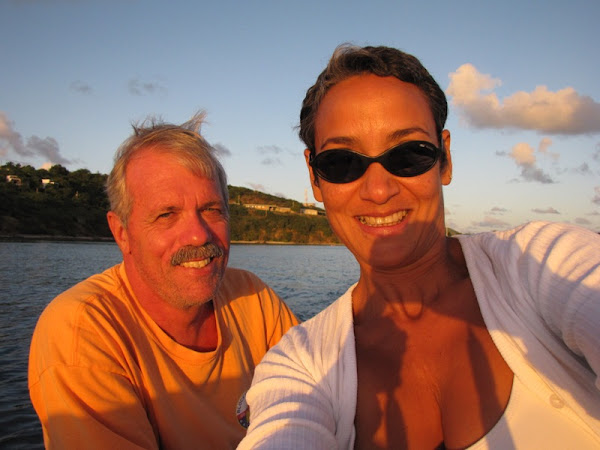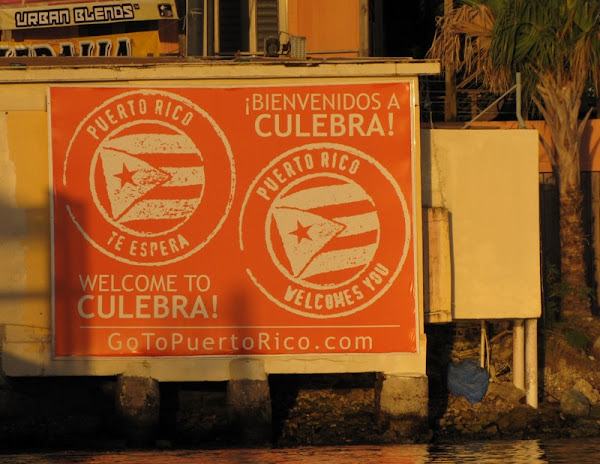We had a great sail from Montserrat to Guadeloupe, although the wind kicked up a bit the last couple of hours so we had to “reef down” (adjust the sails to make them smaller), and we arrived in Deshaies (pronounced De-hay) early Sunday afternoon. A fairly small harbor, naturally carved into the hills and pretty well protected from the prevailing wind and swells, together with a quaint small village ashore make Deshaies a popular stopover spot for yachts moving north and south through the Caribbean, and we anchored among a dozen sailboats with flags from several countries (including one that I still haven’t been able to identify). As we set the anchor a small sea turtle surfaced alongside the boat, popped his head up and watched us, as if to say “Do I know you?”
We were a little beat after two longish days in a row of sailing, so relaxed a bit before putting the dinghy in the water and going ashore in late afternoon. It was really quiet in town, but we found a little grocery store and got some local bananas and veggies, and located the boulangerie (bakery), so we could get some fresh French bread in the morning - the French take their bread very seriously, and getting fresh bread in the morning is a treat - it’s delicious!
The next day (Monday), while listening to the “Coconut Telegraph” cruiser’s net on the SSB radio, a boat in Nevis asked if anybody knew if the strike in Guadeloupe was over. Strike? What strike? We went ashore and found Customs and cleared in. No problems, even though our papers (from Nevis) didn’t say anything about Guadeloupe being our next port as they should have (Ahhhh, I can breathe again). We asked about the strike, and in broken English (our French is rudimentary at best) the Customs officer explained that for several weeks there had been a general strike going on, protesting high taxes and gasoline prices. The gas stations all over the island are closed, no taxis, no rental cars, no garbage pickup (that explains the mound of trash we saw walking to Customs), etc. Hmmmm…that may make it just a little more difficult to explore the island!
Although physically and geologically very close, and with very similar climate, flora and fauna, the French islands (especially Guadeloupe & Martinique) are worlds apart developmentally and culturally from the former British islands. Different architecture, language, money and sensibilities makes exploring even a little more fun and challenging.
The little village of Deshaies, stuck way up on the northwest tip of Guadeloupe, is a bit off the beaten track for most land based tourists, and far from the island’s population center at Pointe Pitre. The handful of little shops and restaurants that ring the harbor were pretty empty, with very little automobile traffic on the streets…the strike had hit the town pretty hard, and was the #1 topic on everyone’s lips. For some reason Guadeloupeans seem to like to strike, and the island is sort of famous for it, so while people were peeved, they were also generally resigned to it.
We spent a few days walking around the area, trying out our rusty French, and relaxing. One day I dug out the scuba gear and spent some time cleaning the propeller and bottom of the boat, because even though the water is beautifully clear, it’s also very fertile, and weed and barnacles grow quickly, creating your very own marine eco-system if you let it!
Our fresh water tanks on Avalon only hold about 110 gallons, and we don’t have a reverse osmosis water maker aboard, so after a couple weeks of cooking, cleaning and showering we needed to replenish our supply. The guide book said there was water available ashore, so we loaded a few empty five gallon jerry jugs and about a dozen one gallon jugs into the dinghy and headed over to the fishermen’s dock, inside a small boat marina of sorts (not large enough for us to get Avalon in).
We saw a fisherman cleaning fish and asked, “Ou et l’eau?” while holding up a jerry jug, hoping that was at least understandable, and the guy looked at us quizzically but eventually pointed to a small building a hundred yards away. The building was locked up tight, and we never did figure out what it was for, but an attached spigot shot water out at fire hose like pressure when we opened the tap - voila! It smelled of chlorine a bit, and we wouldn’t be drinking it unless we boiled it first, so we started filling and then shuttled the jugs back and forth to the boat for a couple of hours.
We had dinner one evening at “Barbuto,“ a neat little place overlooking the harbor (just about everything overlooks the harbor here), and had a nice conversation with Elissa, the hostess/owner (her broken English was better than our broken French!), who gave us some background info on the area and of course more on the strike. She and her husband had heard rumors that a strike was imminent, so they had stocked up a little on food and supplies for the restaurant, but business was slow, and you could feel the tension in her voice.
It didn’t sound like the strike was going to be lifted anytime soon, so we looked at the chart and decided to move on to “Iles Des Saintes,” a small group of islands midway between Guadeloupe and Dominica, about 30 miles south of Deshaies. We’d like to come back to Deshaies again sometime…maybe on the way north? Gee, there are starting to be a lot of places we’d like to go back to! In the meantime, onward to the “The Saintes!”


No comments:
Post a Comment